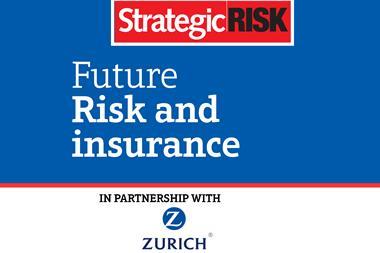Uber, WhatsApp and 3D printing are just three emerging technologies that ring alarm bells for long established sectors such as insurance. But they only point to one thing: change or be changed

Part of a future in risk and insurance report supported by Zurich
Over the course of the next five years, the number of connected devices globally will rise to 50 billion – up from 12 billion today. In addition, the number of people with internet connections worldwide will grow to 5 billion, up from 1.8 billion, in a world population of 7 billion. This explosion of interconnectedness suggests the current rapid pace of change is already speeding up.
Emerging technologies such as 3D printing, artificial intelligence, digital currencies, the Internet of Everything, robotics, and sensors will disrupt traditional business models – and even economies.
“People need to think seriously about interconnectivity. Every risk is now a global risk,” says Aon chief innovation officer
Stephen Cross. “Say I have a small manufacturing site in Nottingham; I have
a website; my people use iPhones. Now I’m globally exposed to some guy in a basement
in Russia hacking into my system, into my clients’ data, and closing me down. Digital wildfire is out there, and we need to be cognisant of what can happen.”
Cross adds, however: “I disagree with the word disruptive, because it suggests that the disrupter is the bad guy.” Instead, risk and insurance professionals should be cultivating their own disruptive thinking, he says.
“Disruptive innovators, as I call them, address inefficiencies in the existing process. Taxi cabs have existed forever, but Uber has put the business on a highly efficient model,” he says. “When you get in, the driver presses start on his or her app – that’s when the commercial driver insurance starts. When he or she presses stop, it produces a receipt and it stops the insurance. That’s usage-based insurance taken to the ultimate.”
Tackling inefficiencies
Innovative technologies that tackle inefficiencies are popping up everywhere. Take 3D printers, which are revolutionising product design and distribution.
“Sales of 3D printers are rocketing. They’re a very important part of our product range,” says Alex Butt, global head of risk for UK-based distributor Electrocomponents.
The company has a product catalogue comprising half a million lines, from electro-components to test and measurement equipment to engineering tools and consumables. It sells mid-range 3D printers for about £400 (€564) each, generating annual revenues from this product of €1.4m – a figure set to rise to €7m in two years.
Alongside the printers, Electrocomponents offers Design Spark Mechanical, a free-to-download 3D design software package.
The software and printer combination is used by engineers and enthusiasts for efficient product prototyping that promises to save them more time and money than with traditional methods. “There is a risk of counterfeiting,” explains Butt. “We try to educate customers about what they can and cannot do with 3D printers.
“And there is a risk around customer expectation of the product.”
Such risks emerge hand-in-glove with the opportunities afforded by the new technology. A further risk is that digital product designs for 3D printers can be used to circumvent export laws that ban the sale of certain products to countries such as North Korea.
Butt emphasises that 3D printers are particularly ill-suited to manufacturing weaponry, however, because they use plastic and not metal, although he says they can be used for prototyping.
Telecoms challenges
Businesses of all types are feeling the effects of disruptive technology. In the Netherlands, Bert Schijf, director, risk and reporting, at telecoms provider KPN, says: “One of the main risks for KPN is disruptive technology. When WhatsApp came along, it made our revenue shrink dramatically.
“A lot of those app-based technologies are still heading towards us. It’s one of the things we have on our radar.”
KPN pays for frequencies so that it can deliver a telecoms network to customers, but when developers create new services delivered over the internet to customers’ handsets – particularly messaging services such as WhatsApp, Facebook Messenger and Viber, which enables free internet-based calls – the network provider sells less data for texting and calling.
“There’s not much you can do about it,” says Schijf. “Telecoms companies have to adapt to the new realities.
“A few years ago, most telcos were fighting these developments, but increasingly you see sales of data bundles facilitating use of new apps, and that locks in customers for the future. We’re not fighting, but joining.”
KPN has taken some significant steps towards this. It has set up a ‘new innovation’ department, which is responsible for disrupting the company from within.
Each new idea is put in front of the Big Data and reputation board, which decides whether or not the new initiative complies with strict company rules on data privacy (see box.
Among the innovations on KPN’s risk radar, the Internet of Everything in particular is seen from a business interruption point of view.
“We’re looking at smart solutions, connected services. We could provide connectivity services or platform solutions, but if so, we have to be very clear in the terms and conditions about what we are and are not responsible for,” says Schijf. “If not, and the service fails, we could be held liable.”
Financial services targets
Disruptive innovators have the profitable, but often inefficient, financial services sector in their sights. Insurance, particularly, is ripe for disruption – time is running out for insurers to investigate their inefficiencies and disrupt their own businesses before it is done to them. “Efficiency is an incredibly good thing for our buying customers, so it should be good for risk advisers and for insurers as well,” says Cross.
“Anything that improves risk control or enhances the risk profile should be embraced. It leads to improvement, to social good. Anything that can prevent or improve loss is interesting,” says Cross.
With driverless cars, which are emerging as safer than traditional vehicles, the risk shifts from the driver to the product. The cars have a black box, like aircrafts do, and if something goes wrong it will be treated as product failure.
“When you look at the insurance industry, and the risk industry, you’ve got to look at the process or the product and ask: ‘What is not efficient to the customer?’, and ‘Who is going to change this?’,” says Cross. “The biggest friend of the insurance industry right now is regulation. The stricter capital environment is probably keeping out some of the companies that track massive amounts of data, like Google or Facebook. It keeps them at bay for now. Insurance is a high-value target to disruptive innovators. Insurance is up there as one of the industries that will be disrupted.”
The huge success of price comparison sites is proof that innovations that target inefficiencies from an insurance buyer’s perspective can thoroughly disrupt insurance business models. Peer-to-peer insurance is another emerging example, as is real-time insurance, which could sweep away year-long contract-based deals. Arguably, it is long overdue.
Cross says many questions must be tackled. “‘Whoever decided that there will be an annual renewal date?’ and ‘Why can’t I purchase insurance until the day I want to cancel it?’ … You can price and model changes to it, like a variable mortgage. ‘Why is insurance so far behind on something that’s a dynamic marketplace?’, ‘How did my risk profile change a minute before renewal date at midnight to a minute after and you come up with a completely different price?’. The reality is that the price of my risk, and the price of the marketplace, adjusted many times over the period of the contract.”
Innovators looking to disrupt financial services are targeting the banks as well. Peer-to-peer money platforms are enabling customers to avoid hefty bank charges on overseas transfers and currency exchanges. New digital currencies such as Bitcoin are an attractive option for people in places where the local currency is weak, such as Argentina, where it’s used by traders.
In Greece, which endured a week-long bank shutdown during the recent bailout talks, people will inevitably turn to alternative systems, despite the potential risks around their lack of regulation.
When it comes to exploiting some of the undoubted inefficiencies in insurance, risk managers are leading the way by questioning how things are done. “The next generation of risk managers, the buyers of commercial insurance, are very data-savvy, very technology-savvy. They are looking for different types of information, and different types of solution,” says Cross.
“The profile of the buyer of today is not the same as the profile of the buyer of tomorrow. A question we get all the time is: ‘How do
you pick the markets that best suit my specific risk? I’m different; I don’t want to be class underwritten. Tell me how best to align my risks’. We are working towards trying to show customers how we pick markets. And it’s not anecdote, which is the broking of the past, it is fact-based and provable, coupled with the sentiment of how people see things. That’s where we are going.”
KPN’s golden rules for processin customer data
1. Everything you do with customer data could affect customer privacy
2. Anonymised data is not personal data and can be freely used
3. Do not collect more data or store data longer than needed
4. Use traffic data for marketing or analytics only with the explicit approval of customer
5. Customer approval must be based on detailed information, given explicitly, in advance




















No comments yet